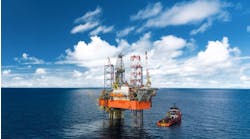Classification society ABS has signed a memorandum of understanding (MOU) with the Agency of the Republic of Kazakhstan for Emergency Situations, which represents the Kazakh Coastal State Authority. The MOU establishes a formal framework for technical collaboration between the two organizations with respect to offshore oil and gas operations.
The agreement recognizes ABS' classification and certification services for offshore oil and gas facilities in the Kazakhstan sector of the Caspian Sea, which is in the northeast portion of the of the sea and home to some of the largest known oil fields.
The formalized working relationship establishes the region's compliance with the relevant Rules and Guides of ABS. This includes plan review and survey work by ABS, and establishes a streamlined process of alternative compliance with internationally recognized standards as permitted under Kazakhstan legislation.
One year ago the ABS signed a MOU with the oil and gas safety agency Gosgortechnadzor (GGTN) of the Azerbaijan Republic responsible for offshore development in the northwest sector of the Caspian Sea.
"Formal recognition of ABS technical expertise by the Kazakhstan Republic furthers our efforts in this region," says Antonio Lino Costa, president and COO, ABS Europe. Lino Costa pointed to a variety of ABS projects in the region, notably the Mærsk Explorer/Lider, which became the first semisubmersible deepwater mobile drilling unit built in Azerbaijan and the most technologically advanced in the region, as well as the world-class self-elevating drilling unitTrident 20/Qurtulus. Additionally, ABS classed the Arctic-class drilling rig Parker 257/Sunkar, which was built to tap the great reserves offshore Kazakhstan.
Working in the Caspian Sea region means addressing the unique challenges of unstable geotechnical features and a highly sensitive environment, says Ibrahim Fawzy, district manager, ABS Europe. Unusually shallow at its northern end, very deep on its southern end, and subject to fierce winters, this landlocked body of water is environmentally sensitive as the breeding ground of caviar-producing sturgeon.
"The Kazakhstan area is most active in field development work, but with water depths of approximately 20 ft, the dynamics of floating structures and shallow hazards for moving vessels are particularly challenging," he explains. "The Azerbaijan area has been active in exploration, with unique challenges due to seismically active mud volcanoes, complex pressure regimes and other unstable geotechnical features in some 3,000 ft of water."
With reserves estimated at upwards of 50 Bbbl under the shallow waters off the Kazakhstan and Russian coastlines, the region with its huge oil and gas reserves will continue to be the focus of international attention.
6/29/2004


